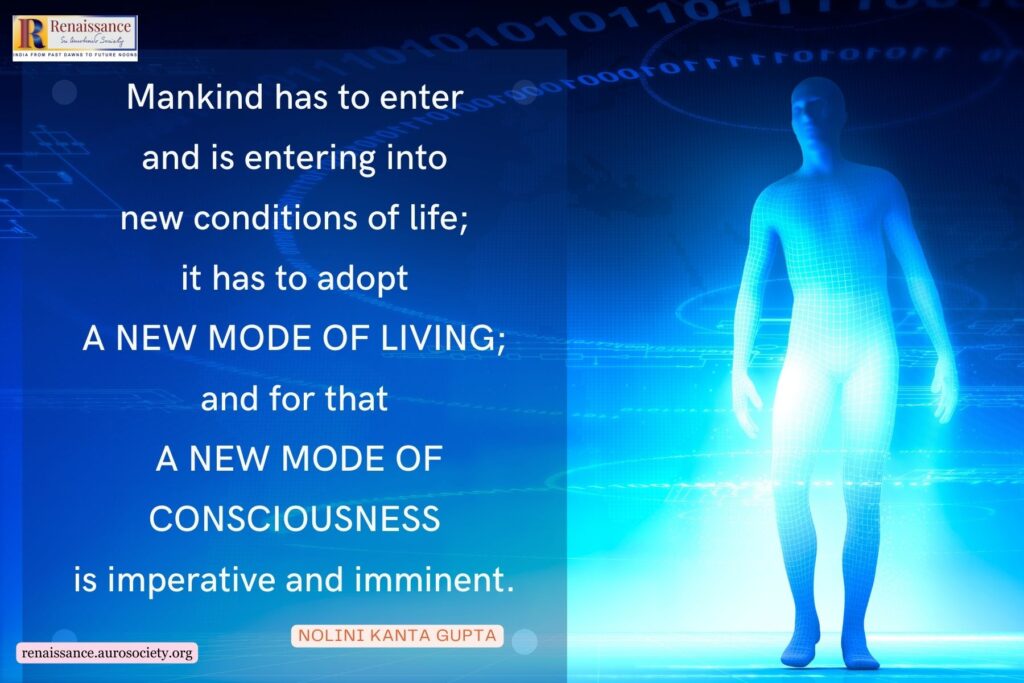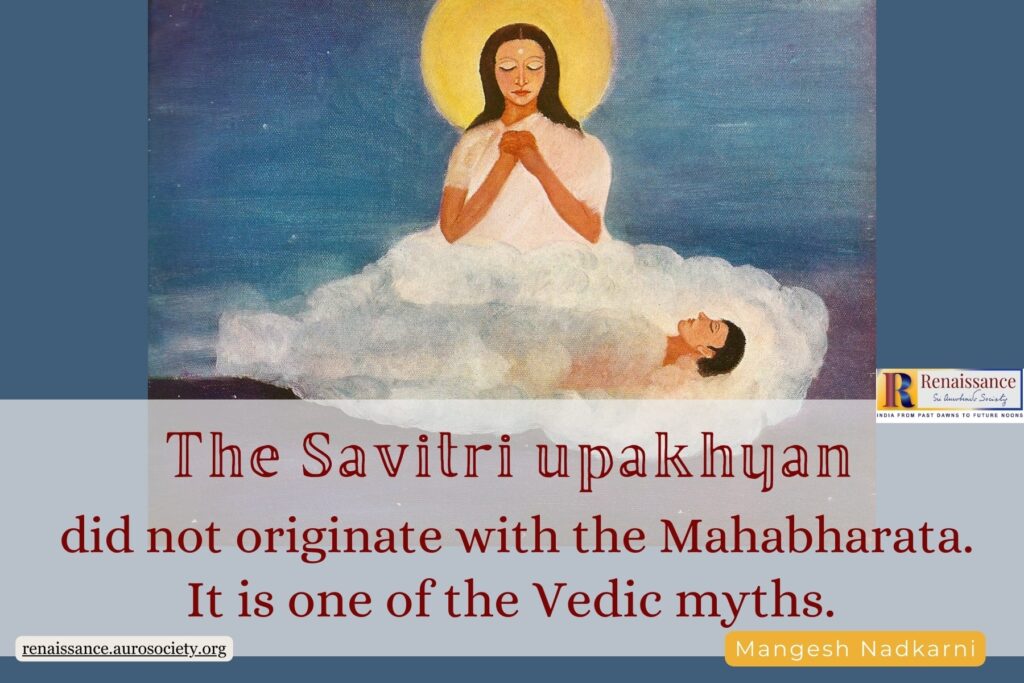Editor’s note: In an essay titled ‘Kurukshetra’ in his ‘Essays on the Gita‘ Sri Aurobindo helps us consider closely the situation from which the Bhagavad Gita arises, “in its largest bearings as a type of human life and even of all world-existence.” A few excerpts are presented here. Only some formatting changes have been made for the ease of online reading such as adding a few subheadings, shortening the paragraphs and highlighting a few key points, with no alteration in the text.

Kurukshetra from ‘Essays on the Gita‘
Life a battle and a field of death, this is Kurukshetra; God the Terrible, this is the vision that Arjuna sees on that field of massacre.
War, said Heraclitus, is the father of all things, War is the king of all; and the saying, like most of the apophthegms of the Greek thinker, suggests a profound truth.
From a clash of material or other forces everything in this world, if not the world itself, seems to be born; by a struggle of forces, tendencies, principles, beings it seems to proceed, ever creating new things, ever destroying the old, marching one knows not very well whither,—to a final self-destruction, say some; in an unending series of vain cycles, say others; in progressive cycles, is the most optimistic conclusion, leading through whatever trouble and apparent confusion towards a higher and higher approximation to some divine apocalypse.
Creation and Preservation by Destruction
However that may be, this is certain that there is not only no construction here without destruction, no harmony except by a poise of contending forces won out of many actual and potential discords, but also no continued existence of life except by a constant self-feeding and devouring of other life.
Our very bodily life is a constant dying and being reborn, the body itself a beleaguered city attacked by assailing, protected by defending forces whose business is to devour each other: and this is only a type of all our existence. The command seems to have gone out from the beginning, “Thou shalt not conquer except by battle with thy fellows and thy surroundings; thou shalt not even live except by battle and struggle and by absorbing into thyself other life. The first law of this world that I have made is creation and preservation by destruction.”
Ancient thought accepted this starting-point so far as it could see it by scrutiny of the universe. The old Upanishads saw it very clearly and phrased it with an uncompromising thoroughness which will have nothing to do with any honeyed glosses or optimistic scuttlings of the truth. Hunger that is Death, they said, is the creator and master of this world, and they figured vital existence in the image of the Horse of the sacrifice.
Matter they described by a name which means ordinarily food and they said, we call it food because it is devoured and devours creatures. The eater eating is eaten, this is the formula of the material world, as the Darwinians rediscovered when they laid it down that the struggle for life is the law of evolutionary existence.
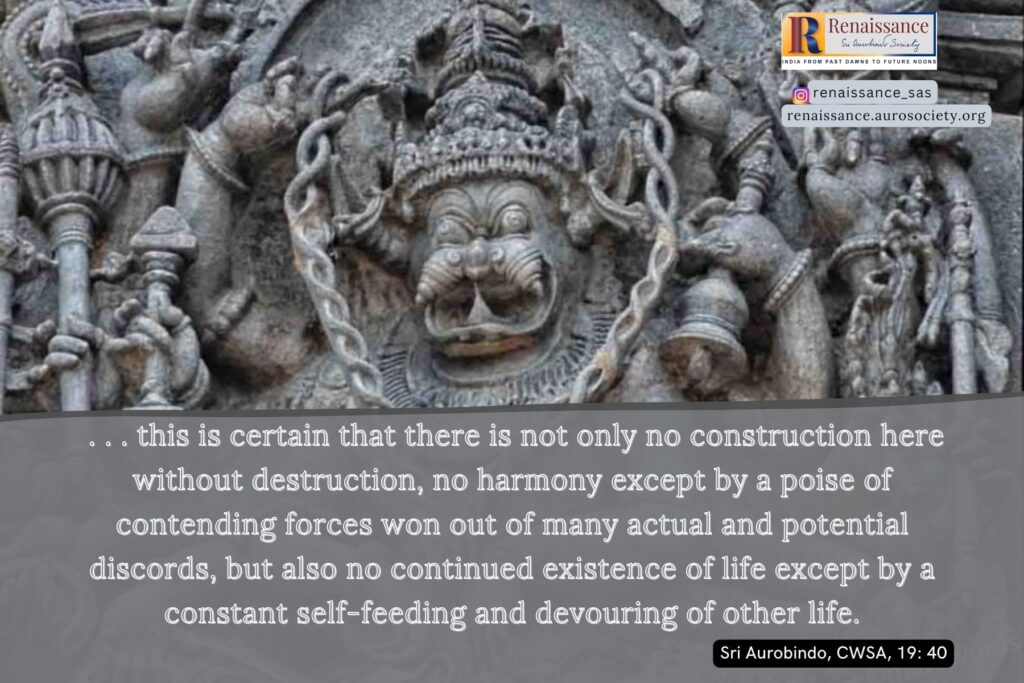
“We must see first what life and the world are”
Modern science has only rephrased the old truths that had already been expressed in much more forcible, wide and accurate formulas by the apophthegm of Heraclitus and the figures employed by the Upanishads.
Nietzsche’s insistence upon war as an aspect of life and the ideal man as a warrior,—the camel-man he may be to begin with and the child-man hereafter, but the lion-man he must become in the middle, if he is to attain his perfection,—these now much-decried theories of Nietzsche have, however much we may differ from many of the moral and practical conclusions he drew from them, their undeniable justification and recall us to a truth we like to hide out of sight.
It is good that we should be reminded of it;
- first, because to see it has for every strong soul a tonic effect which saves us from the flabbiness and relaxation encouraged by a too mellifluous philosophic, religious or ethical sentimentalism, that which loves to look upon Nature as love and life and beauty and good, but turns away from her grim mask of death, adoring God as Shiva but refusing to adore him as Rudra;
- secondly, because unless we have the honesty and courage to look existence straight in the face, we shall never arrive at any effective solution of its discords and oppositions.
We must see first what life and the world are; afterwards, we can all the better set about finding the right way to transform them into what they should be.
If this repellent aspect of existence holds in itself some secret of the final harmony, we shall by ignoring or belittling it miss that secret and all our efforts at a solution will fail by fault of our self-indulgent ignoring of the true elements of the problem.
If, on the other hand, it is an enemy to be beaten down, trampled on, excised, eliminated, still we gain nothing by underrating its power and hold upon life or refusing to see how firmly it is rooted in the effective past and the actually operative principles of existence.

War, a universal principle of our material, mental and moral existence
War and destruction are not only a universal principle of our life here in its purely material aspects, but also of our mental and moral existence. It is self-evident that in the actual life of man intellectual, social, political, moral we can make no real step forward without a struggle, a battle between what exists and lives and what seeks to exist and live and between all that stands behind either.
It is impossible, at least as men and things are, to advance, to grow, to fulfil and still to observe really and utterly that principle of harmlessness which is yet placed before us as the highest and best law of conduct.
Also see:
Sri Aurobindo on the Aryan Ideal of Courage
We will use only soul-force and never destroy by war or any even defensive employment of physical violence? Good, though until soul-force is effective, the Asuric force in men and nations tramples down, breaks, slaughters, burns, pollutes, as we see it doing today, but then at its ease and unhindered, and you have perhaps caused as much destruction of life by your abstinence as others by resort to violence; still you have set up an ideal which may some day and at any rate ought to lead up to better things.
But even soul-force, when it is effective, destroys. Only those who have used it with eyes open, know how much more terrible and destructive it is than the sword and the cannon; and only those who do not limit their view to the act and its immediate results, can see how tremendous are its after-effects, how much is eventually destroyed and with that much all the life that depended on it and fed upon it.
Evil cannot perish without the destruction of much that lives by the evil, and it is no less destruction even if we personally are saved the pain of a sensational act of violence.
Moreover, every time we use soul-force we raise a great force of Karma against our adversary, the after-movements of which we have no power to control. Vasishtha uses soul-force against the military violence of Vishwamitra and armies of Huns and Shakas and Pallavas hurl themselves on the aggressor.
The very quiescence and passivity of the spiritual man under violence and aggression awakens the tremendous forces of the world to a retributive action; and it may even be more merciful to stay in their path, though by force, those who represent evil than to allow them to trample on until they call down on themselves a worse destruction than we would ever think of inflicting.
It is not enough that our own hands should remain clean and our souls unstained for the law of strife and destruction to die out of the world; that which is its root must first disappear out of humanity.
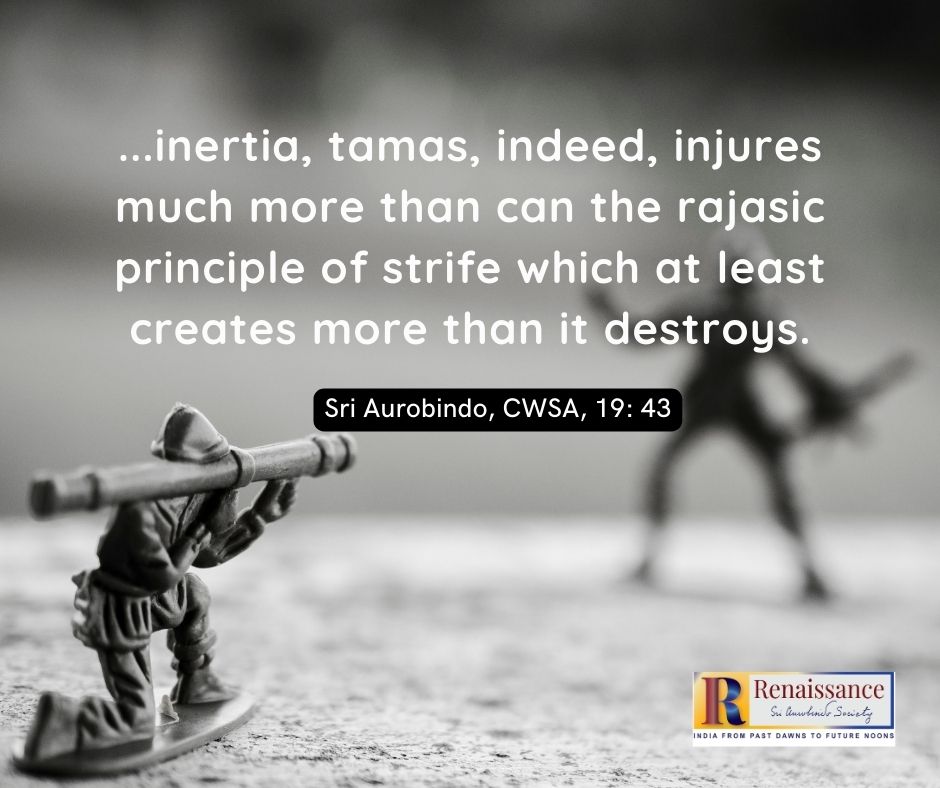
Much less will mere immobility and inertia unwilling to use or incapable of using any kind of resistance to evil, abrogate the law; inertia, tamas, indeed, injures much more than can the rajasic principle of strife which at least creates more than it destroys.
Therefore, so far as the problem of the individual’s action goes, his abstention from strife and its inevitable concomitant destruction in their more gross and physical form may help his own moral being, but it leaves the Slayer of creatures unabolished.
Human history bears witness
For the rest the whole of human history bears witness to the inexorable vitality and persistent prevalence of this principle in the world. It is natural that we should attempt to palliate, to lay stress on other aspects.
Strife and destruction are not all; there is the saving principle of association and mutual help as well as the force of dissociation and mutual strife; a power of love no less than a power of egoistic self-assertion; an impulse to sacrifice ourselves for others as well as the impulse to sacrifice others to ourselves.
But when we see how these have actually worked, we shall not be tempted to gloss over or ignore the power of their opposites.
Association has been worked not only for mutual help, but at the same time for defence and aggression, to strengthen us against all that attacks or resists in the struggle for life. Association itself has been a servant of war, egoism and the self-assertion of life against life. Love itself has been constantly a power of death. Especially the love of good and the love of God, as embraced by the human ego, have been responsible for much strife, slaughter and destruction.
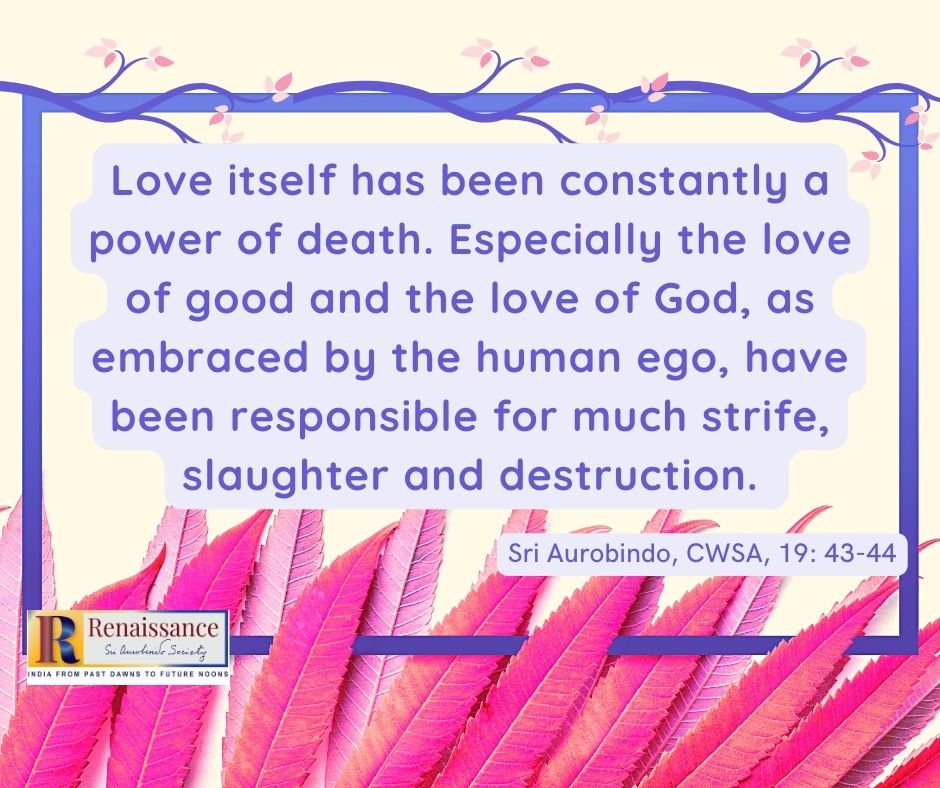
Self-sacrifice is great and noble, but at its highest it is an acknowledgment of the law of Life by death and becomes an offering on the altar of some Power that demands a victim in order that the work desired may be done. The mother bird facing the animal of prey in defence of its young, the patriot dying for his country’s freedom, the religious martyr or the martyr of an idea, these in the lower and the superior scale of animal life are highest examples of self-sacrifice, and it is evident to what they bear witness.
But if we look at after results, an easy optimism becomes even less possible.
See the patriot dying in order that his country may be free, and mark that country a few decades after the Lord of Karma has paid the price of the blood and the suffering that was given; you shall see it in its turn an oppressor, an exploiter and conqueror of colonies and dependencies devouring others that it may live and succeed aggressively in life.
The Christian martyrs perish in their thousands, setting soul-force against empire-force that Christ may conquer, Christianity prevail. Soul-force does triumph, Christianity does prevail,—but not Christ; the victorious religion becomes a militant and dominant Church and a more fanatically persecuting power than the creed and the empire which it replaced.
The very religions organise themselves into powers of mutual strife and battle together fiercely to live, to grow, to possess the world.
All which seems to show that here is an element in existence, perhaps the initial element, which we do not know how to conquer either because it cannot be conquered or because we have not looked at it with a strong and impartial gaze so as to recognise it calmly and fairly and know what it is.
We must look existence in the face if our aim is to arrive at a right solution, whatever that solution may be. And to look existence in the face is to look God in the face; for the two cannot be separated, nor the responsibility for the laws of world-existence be shifted away from Him who created them or from That which constituted it.
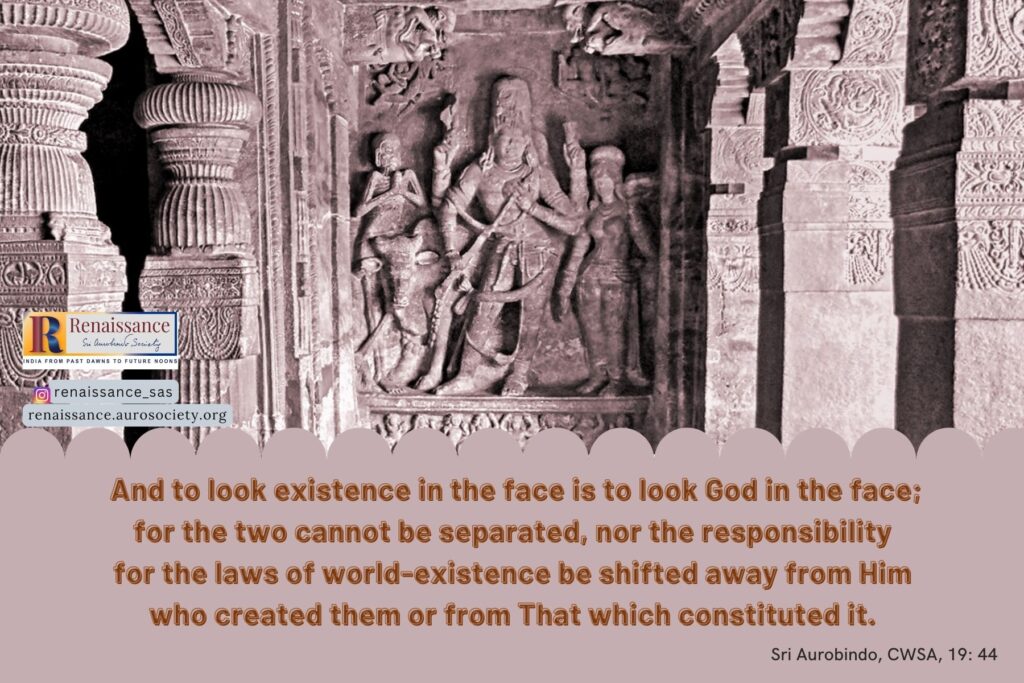
Yet here too we love to palliate and equivocate.
We erect a God of Love and Mercy, a God of good, a God just, righteous and virtuous according to our own moral conceptions of justice, virtue and righteousness, and all the rest, we say, is not He or is not His, but was made by some diabolical Power which He suffered for some reason to work out its wicked will or by some dark Ahriman counterbalancing our gracious Ormuzd, or was even the fault of selfish and sinful man who has spoiled what was made originally perfect by God.
As if man had created the law of death and devouring in the animal world or that tremendous process by which Nature creates indeed and preserves but in the same step and by the same inextricable action slays and destroys.
It is only a few religions which have had the courage to say without any reserve, like the Indian, that this enigmatic World-Power is one Deity, one Trinity, to lift up the image of the Force that acts in the world in the figure not only of the beneficent Durga, but of the terrible Kali in her blood-stained dance of destruction and to say, “This too is the Mother; this also know to be God; this too, if thou hast the strength, adore.”
And it is significant that the religion which has had this unflinching honesty and tremendous courage, has succeeded in creating a profound and wide-spread spirituality such as no other can parallel. For truth is the foundation of real spirituality and courage is its soul. Tasyai satyam āyatanam.
From our archives:
The Mahakali Aspect of the Divine Mother
All this is not to say that strife and destruction are the alpha and omega of existence, that harmony is not greater than war, love more the manifest divine than death or that we must not move towards the replacement of physical force by soul-force, of war by peace, of strife by union, of devouring by love, of egoism by universality, of death by immortal life.
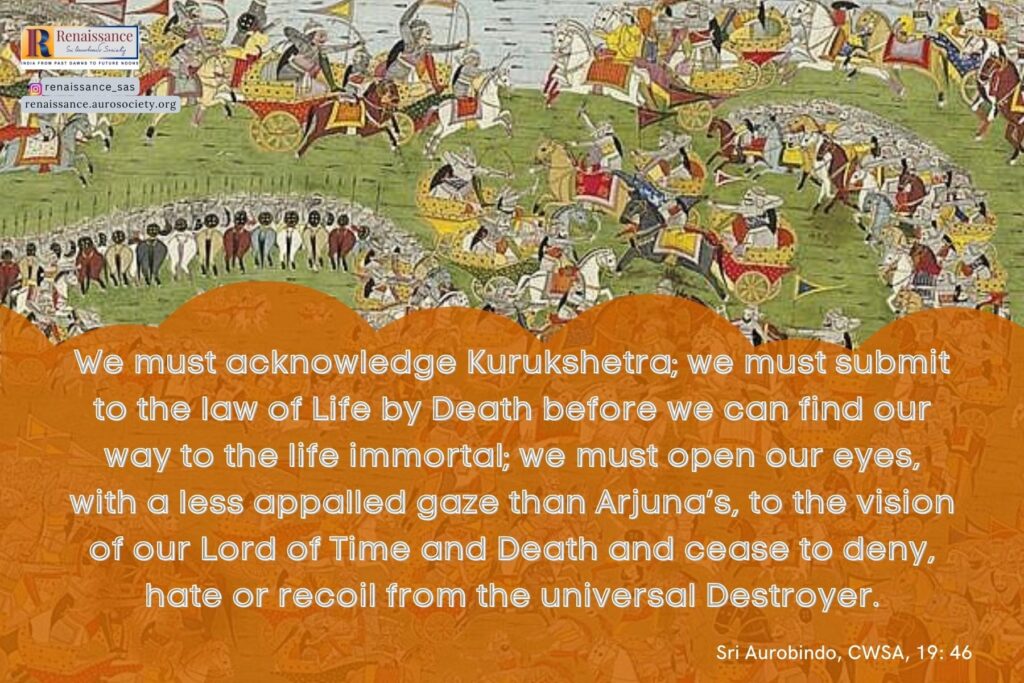
God is not only the Destroyer, but the Friend of creatures; not only the cosmic Trinity, but the Transcendent; the terrible Kali is also the loving and beneficent Mother; the lord of Kurukshetra is the divine comrade and charioteer, the attracter of beings, incarnate Krishna.
And whithersoever he is driving through all the strife and clash and confusion, to whatever goal or godhead he may be attracting us, it is—no doubt of that—to some transcendence of all these aspects upon which we have been so firmly insisting.
But where, how, with what kind of transcendence, under what conditions, this we have to discover; and to discover it, the first necessity is to see the world as it is, to observe and value rightly his action as it reveals itself at the start and now; afterwards the way and the goal will better reveal themselves.
We must acknowledge Kurukshetra; we must submit to the law of Life by Death before we can find our way to the life immortal; we must open our eyes, with a less appalled gaze than Arjuna’s, to the vision of our Lord of Time and Death and cease to deny, hate or recoil from the universal Destroyer.
~ Sri Aurobindo, CWSA, Vol. 19, pp. 40-46

~ Design: Beloo Mehra

